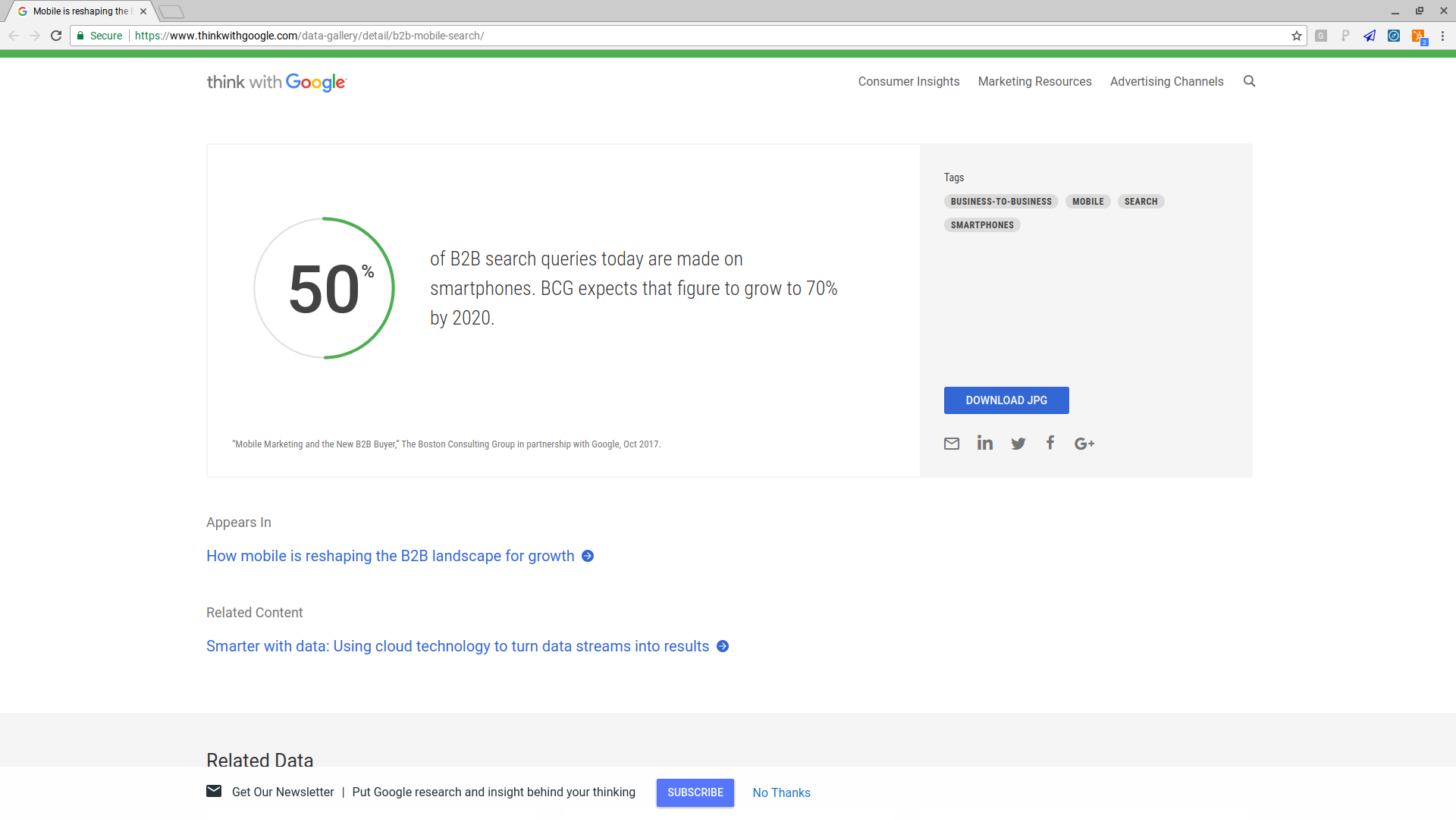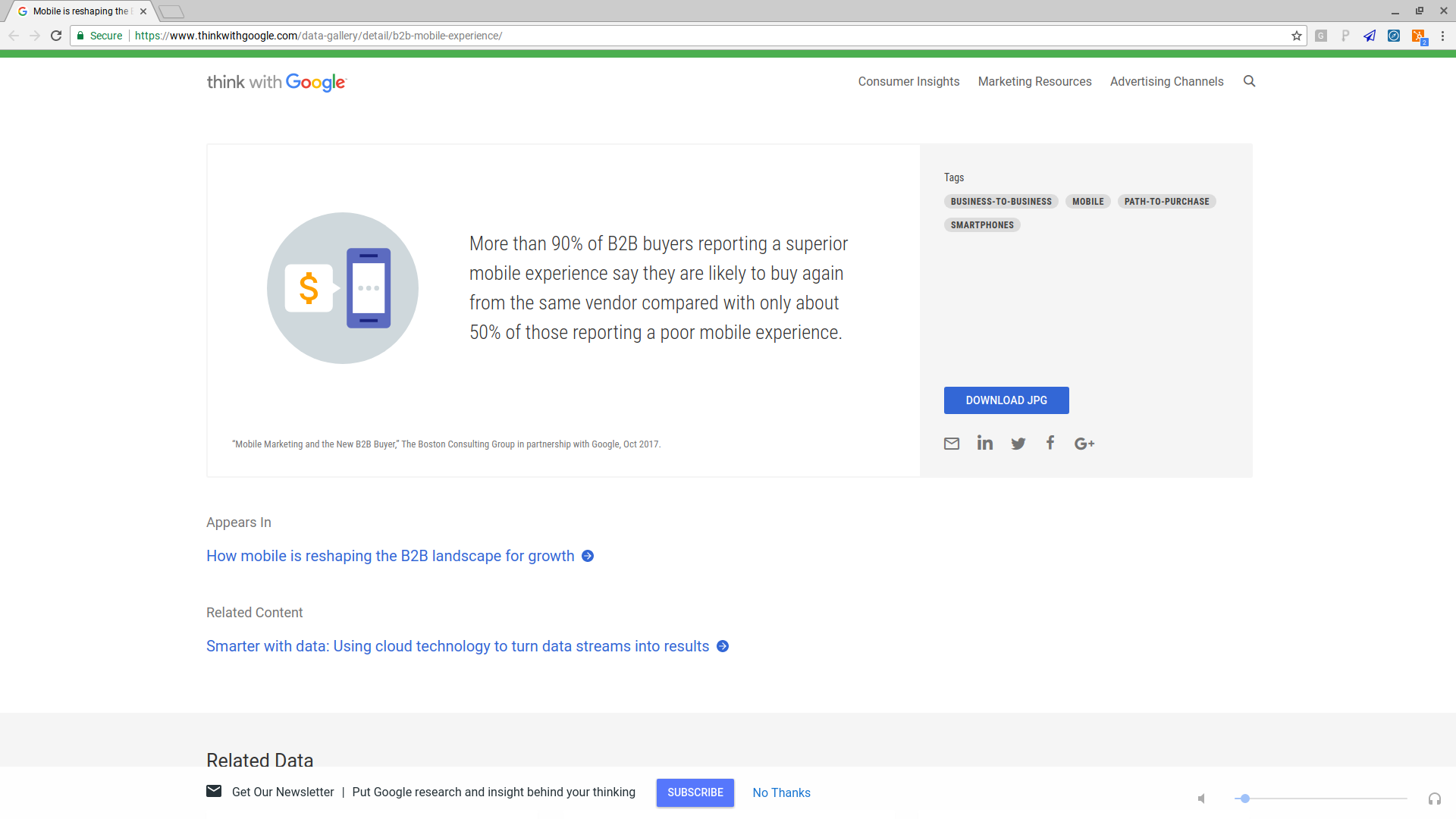Doing business has always been about connections. There was a time when business could be done with a handshake and a beer. Mobile search changed all that. Today, it’s a digital handshake and an emoji beer.
You need to meet your customers where they are, and where they are is on their phones.
Early in 2016, Google rolled out a mobile-friendly algorithm that meant sites that were mobile-friendly would rank higher in the search results.
While it might seem that this is something that would only have an impact on business-to-consumer sales (B2C), it actually has an impact on business-to-business (B2B) purchasing, too.
The Future Is Now For Mobile Search
There was a time when you needed a laptop to do business. Your contracts were in your word-processing software, numbers that needed to be crunched were in your spreadsheets, and those could only be accessed on a computer.
But today’s smartphones even have those pieces of software in them, which means that many people are able to do business entirely from their phone. Do you expect them to take a step backward and go to a laptop or desktop computer to access your site?
You may be shaking your head no, but the truth is, if your site isn’t mobile responsive, that’s exactly what you’re expecting them to do. Consumers today, whether they’re other businesses or the general public, are increasingly doing business on their terms and their own schedule.
They use their phones to mobile search for what they need while sitting at a traffic light, or waiting for the server to bring their salad at dinner. If you’re not optimized for mobile, they won’t see you in their search results, and if they don’t see you, they won’t go to your website.
50% of B2B searches are done on phones, and that number is expected to increase to 70% by the year 2020. If you aren’t optimized and ready for mobile, you’re will be left behind.
Out Of Sight – Out Of Mind
Mobile search results show the highest ranked sites, ones that are designed or optimized to look good and be easy to navigate on a mobile device. As mentioned before, this is known as a mobile responsive website. One that automatically identifies when a mobile device is being used to view it, and responds immediately with a mobile version of your website.
Think about your own search habits. How often do you go beyond the first page of results? Probably not very often, because you know the best sites, the most trusted sites, are the first ones that come up. That’s where you want to be.
Without a mobile-friendly site, you’ll see a drop in organic ranking, increased bounce rate, and a loss in mobile traffic. All of this will contribute to less traffic overall, which will further push your site down in the organic rankings, creating a snowball effect that costs you customers and money.
Marketing For Mobile Search
Positive engagement is critical to get and retain customers. 74% of people say they’ll return to a mobile-friendly website, while 48% say they get annoyed or frustrated if the site isn’t mobile-friendly. 52% say they won’t engage at all with a company that has no mobile website.
Think about that for a moment… Of 100 potential customers, you’ll lose 52 of them permanently merely by not having a mobile responsive website.
It’s time to start, or increase, your marketing for mobile. How do you do that? Here are a few starting points:
- Create a mobile-responsive website and optimize it for mobile search. Include things like click-to-call buttons and asking to access their location to provide more relevant results, to make engagement as easy as possible for your customers. Hiring someone experienced with this may be well worth the money, if you’re not sure how to do it yourself.
- Combine the data you get from your own mobile apps, website, etc, with the data you can get from other business partners, social media and more to gain more insight into your customers and what they want. This will help you tune your site to provide an even better, more personal experience that will bring your prospects and customer back again and again.
- Set some goals. Now that your site is mobile-friendly, and you’ve gained more insight into your customers, you can determine what your ideal results are.
- Monitor your mobile metrics. Are you seeing the results you hoped for? Are you seeing something completely unexpected? What can you tweak to get better results?
What Does Mobile-Friendly Mean?
Mobile-friendly seems like a pretty straightforward term, but many people don’t fully understand what’s involved. For a site to be mobile-friendly, there are three criteria that matter most when it comes to search engines:
- Content loads quickly – 64% of web users will leave the site if a page doesn’t load within 10 seconds. That’s actually an exaggeration… it’s more like 4 seconds, or less, these days
- Content fits on the screen without scrolling side-to-side, or having to turn the phone horizontally
- The site doesn’t return any mobile-specific errors
Some simple tuning of your current website can make it meet those requirements, and bump your site up in the mobile search results. More than that, however, you’ll be ensuring that your customers aren’t driven away. 35% of executives were unable to complete a purchase because the site they visited wasn’t mobile-friendly.
Consider how much money was lost, not just in that purchase, but all the ones that were lost after that because the executive went elsewhere.
You’ll build customer loyalty, too. A study by Google in partnership with The Boston Consulting Group showed that over 90% of buyers indicated that they would return to the same vendor’s website for future orders if they had a superior mobile experience.
If you thought that just having a website was enough, or underestimated the power of mobile, it’s time to push forward and change that thinking.
Just in case you weren’t convinced about just how serious mobile on the Web really is, here are a few other things you should consider, as you contemplate getting your mobile act together:
- 65% of all email is first opened on a mobile device
- 48% of users start their mobile internet sessions on a search engine
- 56% of B2B buyers frequently use smartphones to access vendors’ content
- 95% of adults primarily use their smartphones to access content/information
In Conclusion
Mobile is the future (present really) of B2B purchasing, and if you want your share of the market, you have to be where the market is: on that little device that fits in someone’s purse or pocket.
Want More Info on How to Grow Your Business?
Check out our website and get a FREE comprehensive analysis on why your site is not performing and how to fix it!



